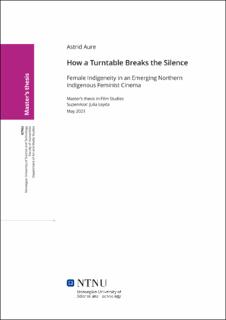| dc.contributor.advisor | Leyda, Julia | |
| dc.contributor.author | Aure, Astrid | |
| dc.date.accessioned | 2023-07-11T17:24:49Z | |
| dc.date.available | 2023-07-11T17:24:49Z | |
| dc.date.issued | 2023 | |
| dc.identifier | no.ntnu:inspera:137202534:49986702 | |
| dc.identifier.uri | https://hdl.handle.net/11250/3077985 | |
| dc.description.abstract | Sammendrag
Denne masteroppgaven retter søkelyset mot en voksende bølge av nordlig, feministisk fiksjonsfilm, frontet av de fire filmene Sameblod (Kernell 2016), Anori (Jørgensen 2018), The Body Remembers When the World Broke Open (Hepburn og Tailfeathers 2019) og Restless River (Cousineau og Ivalu 2019). I en transnasjonal, komparativ filmanalyse, inspirert av interseksjonalitet og andre feministiske og post-koloniale konsepter, undersøker jeg kjønn og nordlig innfødthet slik det uttrykkes i disse filmene. Oppgaven bidrar til akademiske felter innenfor kjønns-, urfolks- og filmstudier ved å løfte fram urfolksfeminisme, nordlig urfolksfilm og representasjoner av kjønnet urfolksidentitet i samtidsfilm. Komponert som filmatiske joiker/sanger, skaper filmene en særegen stil som fletter orale urfolkstradisjoner med dokumentariske, men også fiksjonelle, vestlige filmkonvensjoner. Gjennom denne formen for narrasjon og estetikk framhever filmene hva det betyr å være kvinne og urfolk fra Nord i dag, at den kvinnelige urfolkskroppen er åsted for fysisk og psykisk vold, og hvilket potensial som finnes for mer mangfoldige og formbare urfolksidentiteter nå og i framtiden. | |
| dc.description.abstract | Abstract
The four female-helmed feature films Sami Blood (Kernell 2016), Anori (Jørgensen 2018), The Body Remembers When the World Broke Open (Hepburn and Tailfeathers 2019), and Restless River (Cousineau and Ivalu 2019) are forerunners in an emerging northern indigenous feminist fiction cinema, which this thesis seek to spotlight. Through a comparative, transnational film analysis guided by intersectionality and feminist post-colonial concepts, this thesis explores contemporary northern gender and indigeneity as articulated in these films. Thus, the text contributes to academic research on indigenous feminism, northern indigenous feature films, and the intersectionality of female indigeneity in the North as presented in contemporary cinema. Shaped as standout cinematic joiks/songs, the films constitute a storytelling practice that meshes indigenous oral traditions with documentarian as well as fictional cinematic conventions. This form enables them to foreground important aspects of what it means to be an indigenous woman in the North today, including how the female indigenous body is a site of physical and psychological violence, and point to the potential of multiple, more variegated, and malleable indigenous identities in the present-future. | |
| dc.language | eng | |
| dc.publisher | NTNU | |
| dc.title | How a Turntable Breaks the Silence
Female Indigeneity in an Emerging Northern Indigenous Feminist Cinema | |
| dc.type | Master thesis | |
